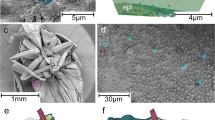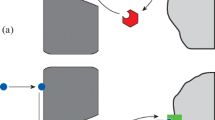Summary
The ultrastructural organization of the setae-bearing sensilla has been elucidated with regard to their position on the scales, their surface structure and their presumable functions. These sensilla have a thickened basis caused by enveloping epithelial cells. Each organ is situated above the appropriate nerve. Entering the organ, this nerve ramifies into axons, which continue between two great central-positioned cells of epidermal origin as far as to the top of them. The central cells end beneath the distal layer of the outer epidermal generation. Leaving the central cells at their top, the axons invaginate into this layer and form, corresponding to the number of axons, 10–15 terminal vesicles. These terminals are — according to recent ultrastructural findings — presumably able to registrate (mechanical) stimuli. The terminals are embedded in masses of tonofibrils, especially at their bases. At the flattened top of the organ long setae are situated centrally but without any direct contact to lower parts of the organ. Mechanical bending of the setae will deform the top of the sensillum which will be recorded by the terminal receptors described.
The movement of the toes is controlled by the sensilla of the scales surrounding the toes, which is important for the climbing mechanism. A decisive function of these organs is the perception of water or other wet substrata. When touching this, the geckos will immediately roll up their toes thus protecting their bristles of the footpads from sticking together.
Zusammenfassung
Die borstenführenden Hautsinnesorgane vonTarentola mauritanica sind in die Epidermis eingesenkt und besitzen aufgrund ihrer Hüllzellen eine verdickte Basis. Jedes Organ befindet sich jeweils über dem dazugehörigen Nerv. Nach seinem Eintritt in das Organ kann man Axone beobachten, die die Sensille in distaler Richtung durchziehen.
Die Hüllzellen umgeben in der Hauptsache zwei gro\e epidermale Zentralzellen, zwischen denen die Axone unter starker Invagination verlaufen. Die Zentralzellen reichen bis zur distalen Zellschicht der Äu\eren Epidermisgeneration. Die Axone invaginieren nach Verlassen des Zentralzellenbereichs in diese Schicht und bilden dort 10–15 Terminalblasen, die als Stellen der Reizaufnahme anzusehen sind. Sie liegen nahe unterhalb des Sensillendeckels, der oft mehrere lange Zentralborsten aufweist. Eine Auslenkung der Borsten dürfte sich als Deformation des Deckels auswirken, der wesentlich dünner ist als das OberhÄutchen au\erhalb des Sensillenbereichs.
Die Bedeutung der Sensillen auf den Zehenrandschuppen liegt in der Kontrolle der Zehenbewegung und in der FÄhigkeit, Wasser aufgrund der OberflÄchenspannung zu perzipieren. Bei Kontakt mit feuchten Medien werden die Zehen augenblicklich dorsal aufgerollt und die Haftborsten so vor Verklebung geschützt.
Similar content being viewed by others
Literatur
Andres, K.H.: Morphological criteria for the differentiation of mechanoreceptors in vertebrates. Abhdl. Rhein. Westf. Akad. Wiss., Westd. Verl. Opladen53, 135–152 (1974)
Cartier, O.: Studien über den feineren Bau der Haut bei den Reptilien. Verh. Phys.-med. Ges. Würzburg1, 281 (1872)
Düring, M.v.: Zur Feinstruktur der intraepidermalen Nervenfasern von Nattern (Natrix). Z. Anat. Entwickl.-Gesch.141, 339–350 (1973)
Düring, M.v.: The radiant heat receptor and other tissue receptors in the scale of the upper jaw ofBoa constrictor. Z. Anat. Entwickl.-Gesch.145, 299–319 (1974a)
Düring, M.v.: The ultrastructure of cutaneous receptors in the skin ofCaiman crocodilus. Abhdl. Rhein. Westf. Akad. Wiss., Westd. Verl. Opladen53, 123–134 (1974b)
Ernst, V., Ruibal, R.: The structure and development of the digital lamellae of lizards. J. Morph.120, 233–266 (1966)
Fromme, H.G., Pfautsch, M., Pfefferkorn, G., Bystricky, V.: Die „Kritische Punkf”-Trocknung als PrÄparationsmethode für die Raster-Elektronenmikroskopie. Microscopica Acta73, 29–37 (1972)
Halata, Z.: Innervation der unbehaarten Nasenhaut des Maulwurfs (Talpa europaea). I. Intraepidermale Nervenendigungen. Z. Zellforsch.125, 108–120 (1972)
Hiller, U.: Zusammenhang zwischen vorbehandelten PolyÄthylen-Folien durch Korona-Entladung und dem Haftvermögen vonTarentola m. mauritanica (Rept.). Forma et functio1, 350–352 (1969)
Hiller, U.: Form und Funktion der Hautsinnesorgane bei Gekkoniden. I. Licht- und rasterelektronenmikroskopische Untersuchungen. Forma et functio4, 240–253 (1971)
Hiller, U.: Licht- und elektronenmikroskopische Untersuchungen zur Haftborstenentwicklung beiTarentola m. mauritanica L. (Reptilia, Gekkonidae). Z. Morph. Tiere73, 263–278 (1972)
Hiller, U.: The inner nervous system of gekkonid scales. In Vorbereitung
Jaburek, L.: über Nervenendigungen in der Epidermis der Reptilien. Z. mikroskop.-anat. Forsch.10, 1–49 (1927)
Leydig, F.: über die Organe eines sechsten Sinnes. Nova acta acad. Carol.34, 1–108 (1868)
Maderson, P.F.A.: Histological changes in the epidermis of the tokay (Gekko gecko) during the sloughing cycle. J. Morph.119, 39–50 (1966)
Maderson, P.F.A.: When? why? and how?: some speculations on the evolution of the vertebrate integument. Am. Zoologist12, 159–171 (1972)
Maderson, P.F.A., Licht, P.: Epidermal morphology and sloughing frequency in normal and prolactin treatedAnolis carolinensis (Iguanidae, Lacertilia). J. Morph.123, 157–171 (1967)
Miller, M.C., Kasahara, M.: Studies on the cutaneous innervation of lizards. Proc. Calif. Acad. Sci.34, 594–568 (1967)
Oppenheimer, E.: über eigenthümliche Organe in der Haut einiger Reptilien. Morphol. Arbeiten5, 445–461 (1896)
Palade, G.E.: A study of fixation for electron microscopy. J. exp. Med.95, 285–298 (1952)
Pflugfelder, O.: Schuppen und Hautsinnesorgane der Blindschlangen. Mikrokosmos10, 297–300 (1972)
Preiss, F.: über die Sinnesorgane in der Haut einiger Agamiden. Jena. Z. Naturw.58, 25–76 (1922)
Schmidt, W.J.: Einiges über die Hautsinnesorgane der Agamiden, insbesondere vonCalotes, nebst Bemerkungen über diese Organe bei Geckoniden und Iguaniden. Anat. Anz.53, 113–139 (1920)
Author information
Authors and Affiliations
Rights and permissions
About this article
Cite this article
Hiller, U. Elektronenmikroskopische Untersuchungen zur funktionellen Morphologie der borstenführenden Hautsinnesorgane beiTarentola mauritanica L. (Reptilia, Gekkonidae). Zoomorphologie 84, 211–221 (1976). https://doi.org/10.1007/BF01578694
Received:
Issue Date:
DOI: https://doi.org/10.1007/BF01578694




